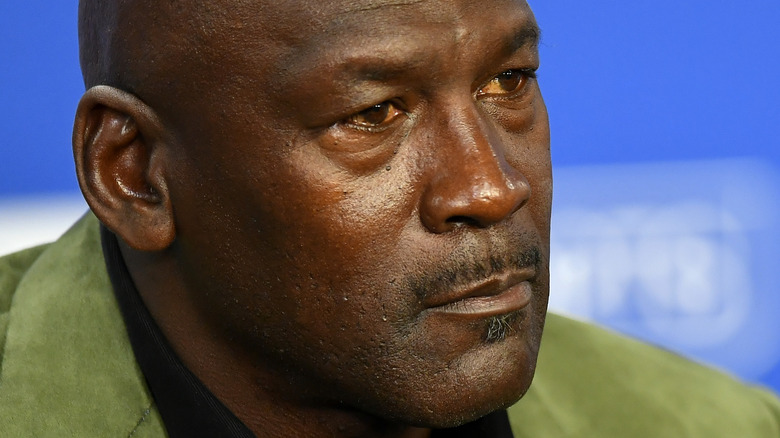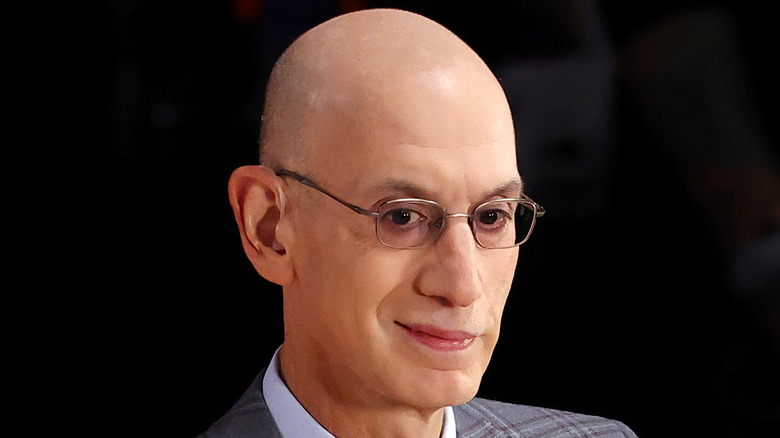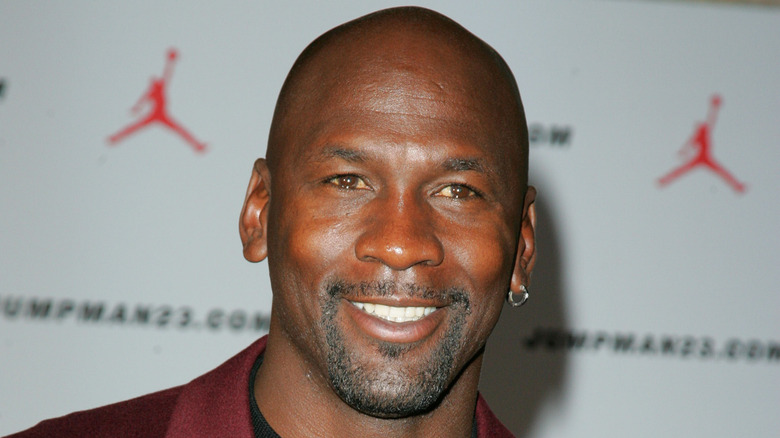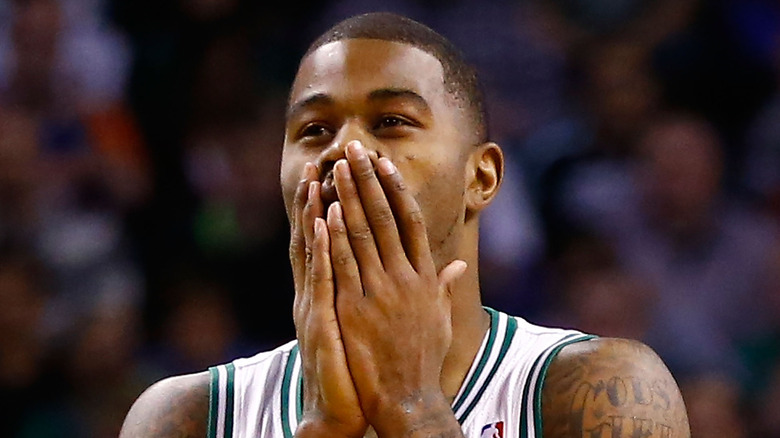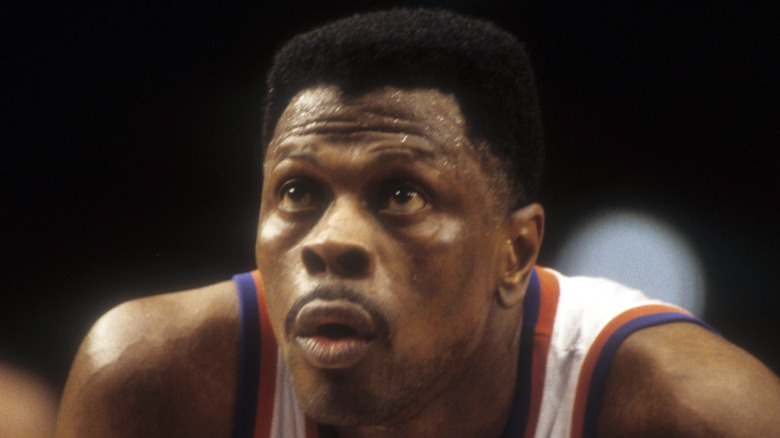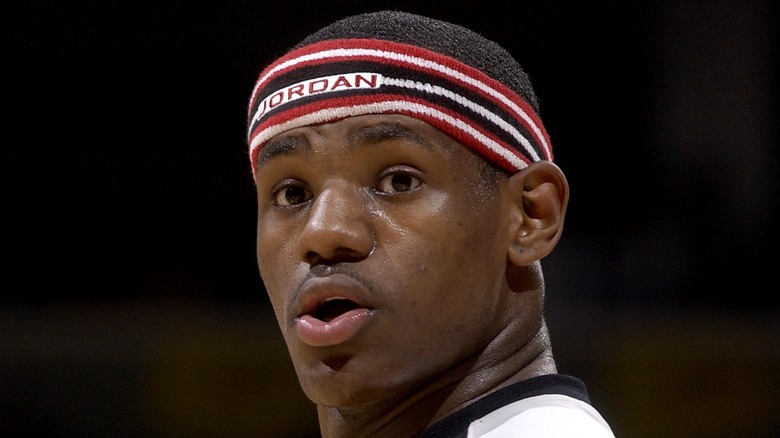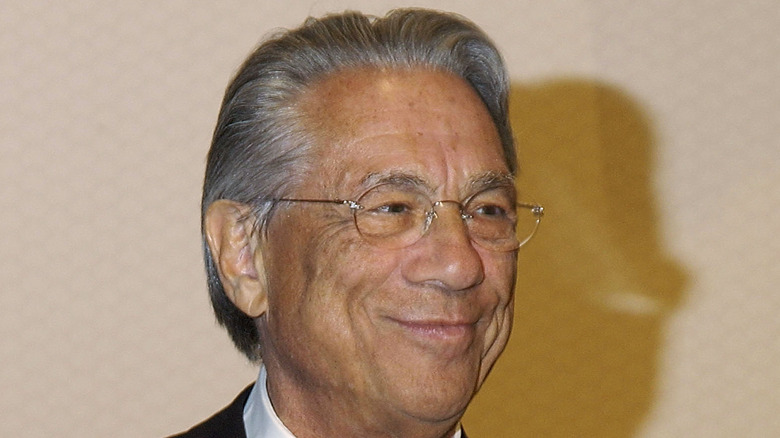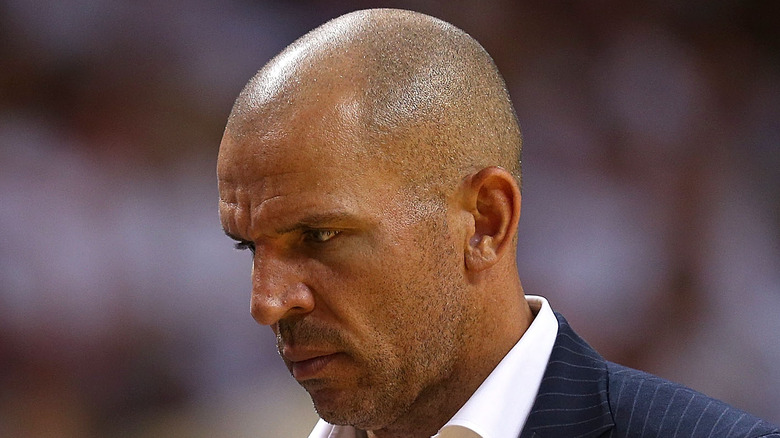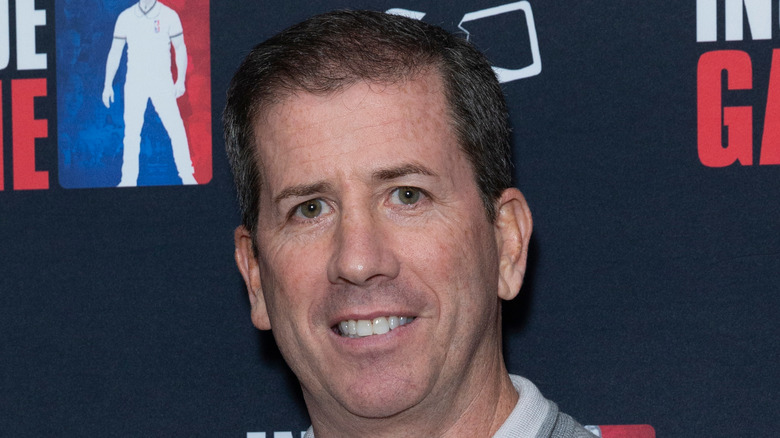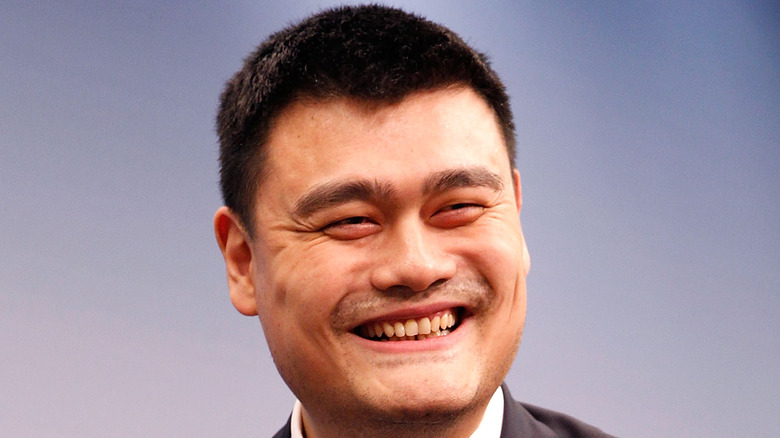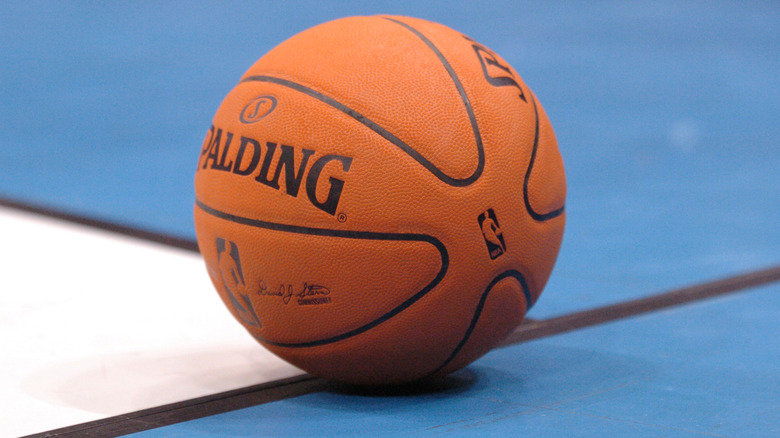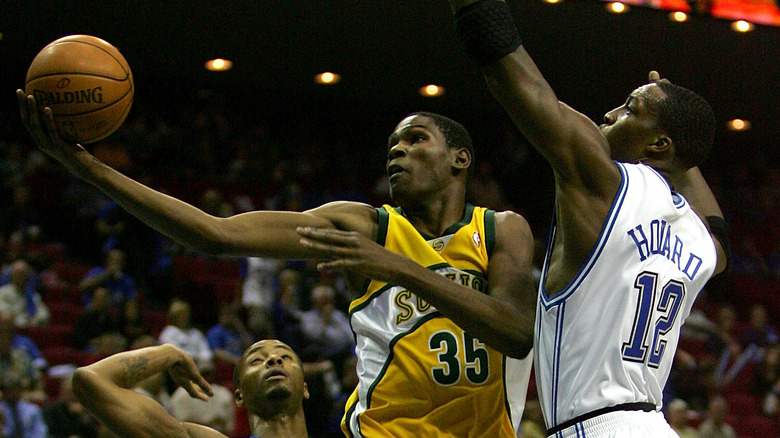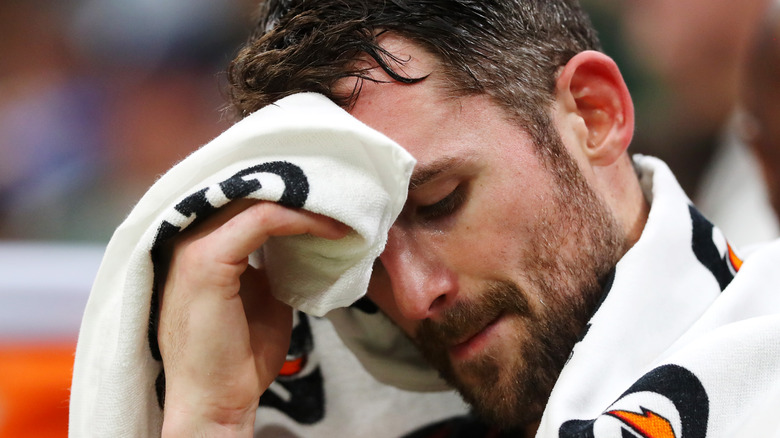Secrets The NBA Tried To Hide
James Naismith, a 31-year-old second-year graduate student at Springfield College, invented the game of basketball in the winter of 1891-1892. After the school's superintendent challenged his students to create a new indoor activity that could be played by college students following the end of football season, Naismith combined many sports popular at the time. He wanted to use big square boxes as goals, but the school's janitor brought peach baskets instead. After cutting a hole in the bottom of the two baskets, basketball swept across the nation.
By 1949, the NBA was born. The sport featured impossibly tall athletes showing off their combination of precision, strength, and speed -– none more popular than the legendary Michael Jordan. Moving into the next era, the NBA introduced fans to other memorable athletes like the teammate duo of big-man Shaquille O'Neal and the late Kobe Bryant on the Los Angeles Lakers. These ballers all paved the way for the next great player in the league, superstar LeBron James.
Many of the best players from the NBA also dominated the sport on an international level, starting with the 1992 Dream Team and rarely losing since then at the Olympics. While the league continued to inspire dreams in fans around the world, it could not avoid nightmarish scandals. Even the biggest names to ever play the game weren't exempt from embarrassing moments the league would rather forget.
There are many fouls to be found in the secrets the NBA tried to hide.
How much money the league makes
While fans continued to grow for the NBA, so did the pockets of owners around the league. John Salley, a former player for the Detroit Pistons, said "we used to play in front of the auto workers. Now we play in front of the auto executives," via ESPN. By the start of the new millennium, an average NBA ticket cost $51.02, per Team Marketing Report. When you factor in the costs of parking, food, and beverages, that $51 ticket price can increase to over $72 per person for game time, so imagine how this adds up over an entire season.
Meanwhile, teams and their owners are raking in the cash. For the 2021-2022 season, the Golden State Warriors showed their stadium seat map and matching prices. The cheapest seats were in the Upper Level, with an average price of $75. Seats in the lower level started at $175, and for those lucky enough to get their hands on courtside seats, tickets ranged from $695 to $1,200 per ticket.
Thanks to attendance, merchandising, and lucrative TV deals, the league constantly increases its bank account. In 2018, the NBA's revenues were the highest ever at an estimated $8 billion, according to Sports Illustrated. That same year, teams averaged a worth of about $1.9 billion. Players also prospered, as the average and median player salaries reached their all-time highs at $7.8 million and $3.5 million, respectively. Though league revenues dropped during the COVID-19 pandemic, NBA commissioner Adam Silver projected $10 billion in revenue for the 2021-2022 season, per CNBC.
The shady side of Michael Jordan
Michael Jordan entered the NBA in 1984, and his rookie season started off with an amazing contract. After passing on Converse — the official sneaker of the league at the time –- and with Adidas unable to make a shoe for him, Jordan signed a sneaker deal with Nike, Marie Claire recapped, via "The Last Dance." "Nike's expectation when we signed the deal was, at the end of year four, they hoped to sell $3 million worth of Air Jordans," David Falk, Jordan's agent, said. "In year one, we sold $126 million," Falk added.
The first shoe, called the Air Jordan 1, debuted in 1985, per Foot Locker. A decade later, Nike was in the midst of a public relations scandal when news broke that Nike used sweatshops in Indonesia to produce some of its shoes. Furthermore, some factories allegedly used child labor. When reporters asked Jordan about the allegations, he said, "I think that's Nike's decision to do what they can to make sure everything is correctly done. I don't know the complete situation. Why should I? I'm trying to do my job," the Chicago Tribune reported.
In his free time, Jordan still displayed some questionable behavior. He was known to enjoy gambling while playing golf with Richard Esquinas, who claimed that the two would wager $1,000 per hole. In Esquinas' book "Michael & Me: Our gambling addiction ... my cry for help!," Jordan allegedly owed the author $1.2 million but only paid him $200,000, via Golf.
How its players cheated the system
After retiring from the NBA, players are eligible for several perks from the league. This includes the NBA's Health and Welfare Benefit Plan. The program provides "supplemental coverage" to complement their existing health coverage, and it's funded by NBA teams, according to The Compliance and Ethics Blog.
While the plan sounds nice on paper, it apparently wasn't enough for some. In 2021, NBC reported that 18 former players were caught and charged in an attempt to bilk the benefit plan out of almost $4 million. Sixteen of the players were in custody and among the charges were "conspiracy to commit health care and wire fraud." For example, one player claimed to have a root canal procedure in Beverly Hills while he was actually playing basketball in Taiwan. A few other players also claimed to have the exact same procedure on the same set of teeth, which created suspicion by people processing the claims.
According to the report, Terrence Williams was the mastermind of the illegal group, submitting false invoices and claims. In return, Williams received payments that totaled an estimated $230,000. Part of his tactics involved pretending to be an official plan agent and calling the other players to scare them into paying him. The 18 players received about $2.5 million. The league reeled in the face of the allegations and pledged cooperation in the investigation.
The Gold Club incident
Basketball stars inspire fans around the world, and many become celebrities off the court. While the press is often good, NBA players were once caught using their celebrity status for more seedy applications. In 2001, several players from the league were named in a trial involving a strip club and mob scandal surrounding an establishment called The Gold Club. The strip club in Atlanta paired strippers with professional players in order to attract more high-profile types, The Washington Post reported. The owner of the joint, Steve Kaplan, and six other defendants were charged with a number of crimes, including corruption and prostitution.
A witness testified that Larry Johnson, the forward who played for the Charlotte Hornets and later the New York Knicks, once "begged" Kaplan to provide him with a stripper to join him at a hotel, which was allegedly the inspiration for Kaplan's entire operation. NBA star Patrick Ewing, a 2008 member of the Basketball Hall of Fame, and MLB star Andruw Jones admitted during Kaplan's trial that although no money exchanged hands, the dancers did perform for them sexually, per ABC. None of the NBA players were charged with crimes. Kaplan ultimately paid a $5 million fine and The Gold Club was forced to shut down, CNN reported.
The complicated age limits to play in the NBA
Some of the best players in the NBA actually never went to college. The modern trend started in 1995 when the Minnesota Timberwolves took Kevin Garnett as the 5th overall pick. The following year, Kobe Bryant from Pennsylvania went straight to the NBA, per ESPN. Stars like LeBron James also went right from high school into the professional league. In fact, the sports network aired its first high school basketball game in 2002 when James was a senior at St. Vincent-St. Mary High School in Ohio. He was the two-time best player in the country for his age group and was projected to be the first overall draft pick in the NBA. This was the only major professional sport to allow the immediate jump into the pros, as the NFL, MLB, and NHL all had development leagues or required some college.
A few years later, the NBA ruled that high school athletes would be required to play for a college for a minimum of one year, per Bleacher Report. The move was controversial since some considered it a block to a player's right to hold a job.
In 2019, the NBA began discussing the end of its "one-and-done" era and lowered the league age minimum to 18 years old, ESPN reported. One of the biggest points of contention with the players' association was the league's desire for draftees to provide medical information.
The Donald Sterling story
There has been a long history of shady owners in sports, and one of the most disgraced was the former owner of the Los Angeles Clippers, Donald Sterling. The billionaire bought the franchise, then the San Diego Clippers, in 1981 for $12.5 million dollars, per Forbes. In 2014, TMZ released a recording of Sterling talking about attendees and players with his girlfriend, V. Stiviano. Among the most racist things he said was for Stiviano to "not to bring them to my games," referring to Black fans. He even specifically called out NBA legend Magic Johnson from the Los Angeles Lakers and said, "don't bring him to my games."
In an interview with Anderson Cooper for CNN, Sterling said, "I'm not a racist." The former owner claimed he was set up by his girlfriend to make the comments and explained, "that's not the way I talk." As for Sterling's delayed apology about the entire situation, he said he was "emotionally distraught." Sterling also hoped his 35 years in the NBA would alleviate the situation and asked, "Am I entitled to one mistake?" In the aftermath, Sterling was banned for life from the NBA and fined $2.5 million. Plus, NBA Commissioner Adam Silver requested other team owners in the league to pressure Sterling to sell his team. Though he didn't initially want to separate from his team, Sterling sold the Los Angeles Clippers to ex-Microsoft CEO Steve Ballmer for a staggering $2 billion.
Jason Kidd's troubled history
As one of the best players ever in the NBA, Jason Kidd entered the Basketball Hall of Fame in 2018. The point-guard was known for his on-court vision and selflessness. This seemingly nice aspect while playing didn't always come through in his private life. For example, in 2001, Kidd was arrested for domestic violence against his wife at the time, ESPN reported. The basketball star pleaded guilty to the charge and had to attend anger management sessions.
Throughout the rest of the career, Kidd was a part of multiple controversies, several times involving his coaches and management. After missing the first two games as head coach of the Brooklyn Nets for a drunk driving incident, he was part of "Sodagate." Toward the end of a game between his team and the Los Angeles Lakers, Kidd spilled a cup of soda onto the court. Only, it wasn't an accident, as ESPN recapped.
Kidd later returned to the Mavericks as head coach in 2021. The team's CEO Cynt Marshall, herself a domestic violence survivor, had "long, intense" talks with Kidd about what she called his "journey," The Dallas Morning News reported. Marshall said, "I didn't find any reason not to hire him," and Kidd joined the franchise.
The acts of a shady referee
Sports and gambling have long been intertwined. Unfortunately, sometimes this caused sketchy behaviors like Chicago White Sox baseball players throwing the World Series just to earn some extra cash. In 2007, allegations surfaced in the NBA that one of its veteran referees, Tim Donaghy, influenced games to benefit himself or his friends because they'd bet on the outcome, The New York Times reported. Allegedly, for two seasons, Donaghy would make the wrong calls at critical times to try and sway the outcome of the games. Even more, reportedly, he was under pressure from the mob make the crooked calls.
As detailed in the first report of the scandal by the New York Post, Donaghy fixed at least 10 games in connection with mob members. One source called his associates "dangerous people." This was the first time the league publicly dealt with a game-fixing scheme, and the FBI even became involved. The NBA commissioner said that Donaghy acted alone, and the referee admitted to betting on games that he officiated. Yet, Donaghy never admitted that he fixed the games or altered his calls to affect the outcomes. This was also the same conclusion by the FBI. Later, a detailed review by ESPN claimed that Donaghy's bets favored him. In the end, the disgraced ref resigned from the league and was convicted for criminal acts, serving time until 2009.
The NBA's relationship with China
The relationship between the NBA and fans in China grew even more with the success of Chinese player Yao Ming. The basketball star was 7 feet 6 inches tall and became enshrined in the Basketball Hall of Fame in 2016. Ming played for the Houston Rockets, but after his retirement, his former club caused controversy with China. Daryl Morey, who was the general manager of the Rockets in 2019, tweeted, "Fight for freedom, stand with Hong Kong" in response to protests in Hong Kong, via The New York Times.
The backlash from China was quick and strong — all of the Rockets' Chinese sponsors paused their deals, and the country threatened to not broadcast the team's games, which was a big deal given the millions of dollars coming in from the market. In addition, a couple of exhibition games with the Rockets were canceled.
The situation quickly became a political matter in America. U.S. Senator Josh Hawley sent a letter to the NBA commissioner David Silver expressing his opinion on the league's connection with the Chinese Communist Party. The politician followed up the next year too, again accusing the league of avoiding any comments on China's alleged human rights abuses.
The new ball fiasco
Basketball has always been a sport with limited equipment. Unlike the NFL with gear featuring the latest technology, like innovative helmets, NBA players just need a pair of sneakers and a ball. In 2006, the NBA tried to show it too could use innovation to improve the game and introduced a revolutionary ball. With official sponsor Spalding, the league introduced the "New Ball," Complex recapped. Following the lead of some high schools and colleges, the NBA replaced the classic leather ball with a synthetic, microfiber material. The non-leather material was cheaper and the balls were supposed to have that broken-in feel, even when new.
The rollout was a disaster. The NBA didn't let players try the new basketball until the summer right before the season started. Most immediately hated the change. "It felt like plastic," one former player remembered about the new ball. More than just affecting grip and shooting, the ball also cut some players' fingers, The New York Times reported. As a result, the NBA continued to use the ball but asked Spalding to conduct further tests on the synthetic version.
The synthetic ball didn't even make it to the end of the calendar year. After fewer than three months on the court, the NBA announced the return to classic leather balls, beginning in January 2007. "Our players' response to this particular composite ball has been consistently negative and we are acting accordingly," the commissioner said, via ESPN.
No warning for disappointing fans
Basketball fans in Seattle had a long history with the local team, the SuperSonics. With the signature green and yellow jerseys, the Sonics won their first and only league championship in 1979, per Bleacher Report. In the next era, the team's prospects looked promising once again with the arrival of the college standout from Texas, Kevin Durant. The future star delivered -– Durant won the NBA Rookie of the Year award. Sadly, this was the last time hometown fans could watch the young player. Similar to other leagues like the NFL, the team relocated and left fans in the dust. The Sonics then became the Oklahoma City Thunder as a result of a deal between two wealthy men: Howard Schultz of Starbucks and Clay Bennett of Oklahoma, per The Ringer.
The Charlotte Hornets also have a frustrating history for its fans. The Hornets' first year in town was 1988, but in 2002, the team relocated to New Orleans, per Statista. Charlotte had a new team in 2004 but called themselves the Bobcats. The New Orleans Hornets then rebranded as the Pelicans in 2013, and Charlotte received its rights back to the Hornets name before the start of the next season. Under the direction of owner Michael Jordan, the Hornets received more than just the old name and reclaimed the legacy of the originally named team, Sports Illustrated recapped.
NBA players sometimes suffer in silence
It can be easy to forget that in the midst of all the action on court, there can be more going on with the players than just basketball. Mental health has been a topic that had long been taboo around sports. For example, Olympic great Michael Phelps helped make a documentary about mental health struggles in professional athletes. In the basketball world, Kevin Love was one of the first huge stars to open up about the hidden difficulties that come with being an NBA player. "Everyone is going through something that we can't see," he wrote for The Players' Tribune.
Love recalled having mental health struggles starting in high school. Though he was a gifted athlete, his depression often drove his performance on the court, and he saw himself as just a basketball player instead of a well-rounded individual, according to CNBC. Love tried to distract himself by focusing even more on being one of the best in basketball but he discovered this wasn't the right approach. "You can't achieve yourself out of depression," Love explained. "You can't achieve yourself out of that high level of anxiety," he added.
As a result of Love's story and others, the NBA became proactive to help its players and further stepped up efforts amidst the COVID-19 pandemic. The league issued a statement to its teams recommending "education and awareness materials focused on managing mental health during times of uncertainty and coping strategies for addressing the emotional toll of the pandemic."

